The large blue butterfly relies on the red ant Myrmica Sabuleti to complete its lifecycle, so it would be a disaster for them if the red ant populations decreased so much to be unable to sustain their hungry caterpillars. Unfortunately, this was the case in the UK in the 1960s and 1970s. Numbers of the large blue had already fallen too far for populations to recover when the link between decreasing butterfly numbers, low ant populations and changes to their habitat was discovered (1). In 1979 the large blue butterfly became extinct in the UK. What was the reason behind their drastic decline, and could it be reversed?
Escape to the grassland: uncovering the perfect home for the large blue butterfly
Here we talk about the grasslands where the large blues make their home, their struggle to survive in a changing landscape and what we are doing on nature reserves to benefit them and many other species.
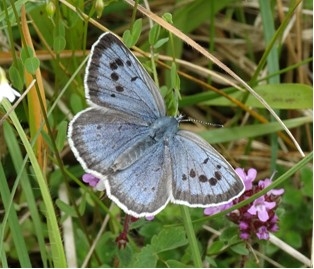
Large blue butterfly on wild thyme. Photo by Alan Sumnall.
Heat seeking ants
The red ants Myrmica Sabuleti were disappearing. The grasslands in which they were found were no longer suitable for their needs, some were lost to changes in land use, but for those grasslands remaining the main factor was the loss of livestock grazing (1). To put it simply: the grass was growing too tall! Places that in the past had been grazed by cattle or sheep were no longer being managed this way or were not being grazed intensively enough and this small change was affecting Myrmica Sabuleti populations (2).
Now you may wonder, why does it matter how tall the grass is, isn’t it better to have meadows filled with wildflowers and tall grasses moving gently in the summer breeze? Well for many species yes, this would be an amazing haven filled with all the food and shelter they need, but not for the large blues and their red ants. Myrmica Sabuleti, like many of us, like to keep their homes nice and warm and the taller the grass the less heat from the sun can penetrate through to the ground (3). Unlike their neighbours the yellow meadow ants, Myrmica Sabuleti don’t create mounds moving the ground surface closer to the heat above (4). Instead, they have to find these warm spots for themselves and in under-grazed grasslands that means moving somewhere else or being kicked out by their cousins Myrmica scabrinodis (1), leaving the large blues behind.
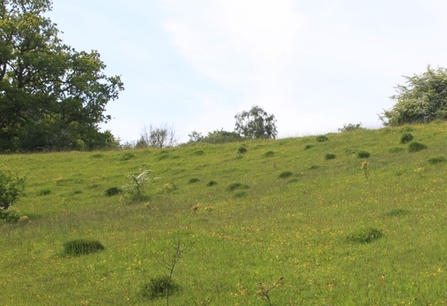
Yellow meadow ant mounds. Photo by Katherine Keates.
A second chance
Once this connection between Myrmica Sabuleti and grass height was discovered a few sites were selected and changes to habitat management put in place to try to increase ant numbers. When Myrmica Sabuleti numbers were deemed high enough large blues from Europe were brought over to try to re-establish UK populations (5). From the 1980s large blues have been successfully reintroduced at a few sites in South West England, including at our nature reserve Daneway Banks, a SSSI limestone grassland. Here we have managed the reserve for several decades with the large blues in mind, making changes to meet their requirements and leading to their successful reintroduction to the reserve in 1999. Alongside our co-owners of Daneway Banks, the Royal Entomological Society, we have given the large blues a suitable home to thrive in through careful management and continued monitoring of populations.
Nature reserve gardeners
So how do we manage the reserve?
When summer is over, the flowers have set seed and the large blue caterpillars are safe in the underground nests of their red ant hosts, onto Daneway Banks come the Welsh mountain ponies and the Balwen sheep. They eat the grasses down and reduce the encroachment of the scrub, creating the conditions needed for the ants to continue to thrive (6). They are hardy breeds selected so that they can weather the cold winter months and will stay on the reserve until the spring keeping the height of the grass low for the ants.
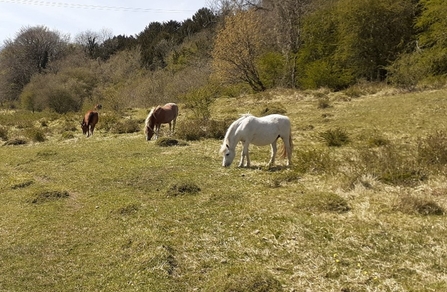
Welsh mountain ponies grazing on Daneway Banks. Photo by Katherine Keates.
As well as grazing the reserve there are other ways we can help the large blues, with a little home renovation here and there. Together with the help of our amazing volunteers, we have reduced the amount of scrub on the reserve, opening up more areas for the large blue feeding plant wild thyme and other grassland species to spread into (7). This has helped increased the volume of large blue butterflies the reserve can support.
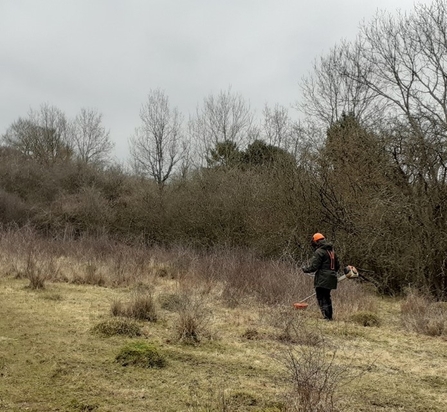
Removing scrub that is encroaching the grassland. Photo by Katherine Keates.
It’s not just about the large blues
Although managing Daneway Banks this way has benefitted the large blue butterfly, in fact many species are positively affected by conservation grazing and reducing scrub on the reserve (7). This has resulted in a rich diversity of animals and plants that live comfortably within its borders.
In the summer sun, a mixture of other butterflies can be seen fliting from flower to flower in an array of colours from the dingy skipper and small heath to the peacock and small blue. If you look close enough the grasses are alive with small creatures. The small areas of scrub around the edge of the site are perfect sanctuaries for the hazel dormouse to curl up in, for roe deer to shelter in and on a sunny day you may see an adder slither out to bask in the sun. This picturesque image is only made better with the accompanying symphony of birdsong echoing all around. A brilliant place to call home not just for the large blues but many other amazing wildlife.
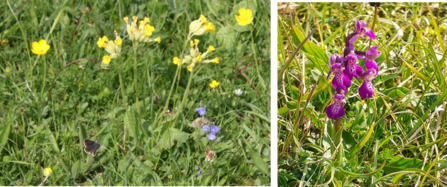
A brown argus butterfly sitting near some cowslips and a green winged orchid. Just a hint of the diversity found at Daneway Banks. Photos by Katherine Keates.
Daneway Banks and other nature reserves may be havens for wildlife, but we are also working to expand outside of reserves to reconnect nature and wildlife throughout the countryside. Look out for next week’s blog where we discover more about Daneway Banks’ neighbouring reserves Siccaridge Wood and Sapperton Valley and how we are trying to encourage large blue’s and other species to spread through the landscape.
References
- Thomas, J. (1980). Why did the Large Blue become extinct in Britain. Oryx. Vol 15, p243-247.
- Casacci, L.P., et al. (2011). Habitat preferences of Maculinea arion and its Myrmica host ants: implications for habitat management in Italian Alps. J Insect Conserv, Vol 15, p103-110
- Elmes, G., & Wardlaw, J. (1982). A Population Study of the Ants Myrmica sabuleti and Myrmica scabrinodis Living at Two Sites in the South of England. II. Effect of Above-Nest Vegetation. Journal of Animal Ecology, 51(2), p665-680.
- Boots, B. & Clipson, N. (2013). Linking ecosystem modification by the yellow meadow ant (Lasius flavus) to microbial assemblages in different soil environments. European Journal of Soil Biology. Vol 55, p100-106
- Thomas, J.A., Simcox, D.J. & Bourn, N.A.D. (2011). The restoration of the large blue butterfly to the UK. In: Soorae, P.S. (eds) Global Re-introduction Perspectives: 2011 More case studies from around the globe. Gland, Switzerland: IUCN/SSC Re-introduction Specialist Group and Abu Dhabi, UAE: Environment Agency-Abu Dhabi. p10-14
- Thomas J.A. (1995) The ecology and conservation of Maculinea arion and other European species of large blue butterfly. In: Pullin A.S. (eds) Ecology and Conservation of Butterflies. Springer, Dordrecht.
- Randle, Z. (2009). Maculinea arion as an indicator of rare niches in semi-natural acid grasslands in South West England and the role of Myrmica species of ant. University of Southampton, School of Biological Sciences, PHD Thesis, pp181

